NCERT Solutions for Class 12 Maths Chapter 6 - Application of Derivatives Exercise 6.3
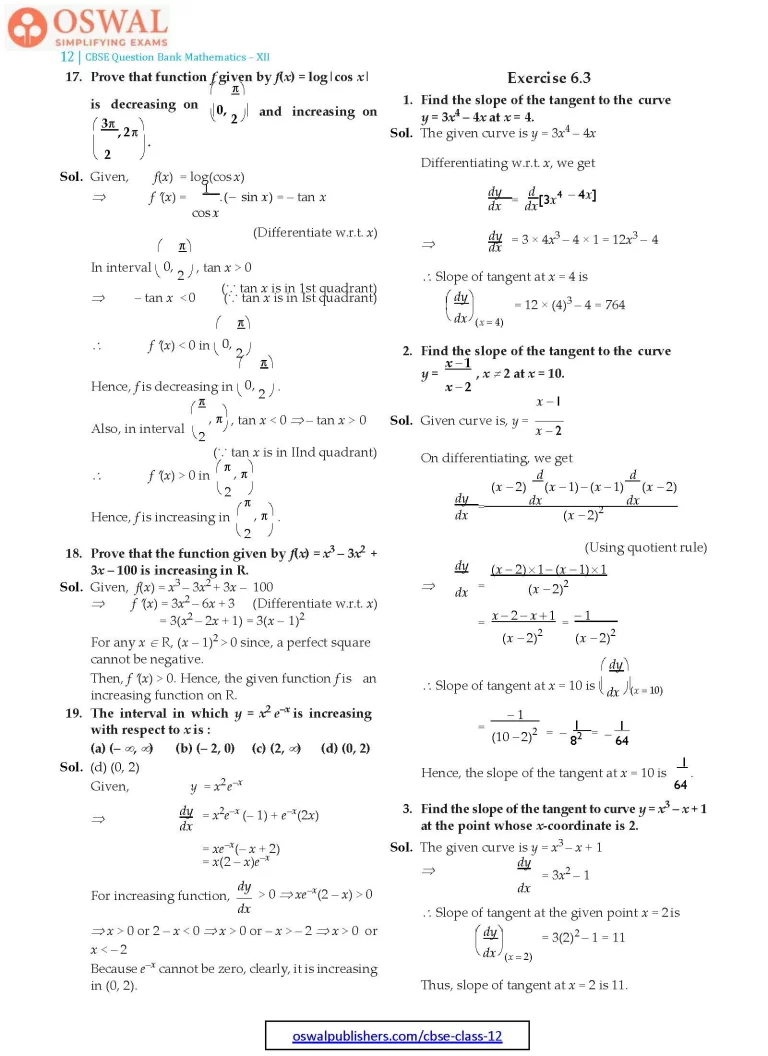
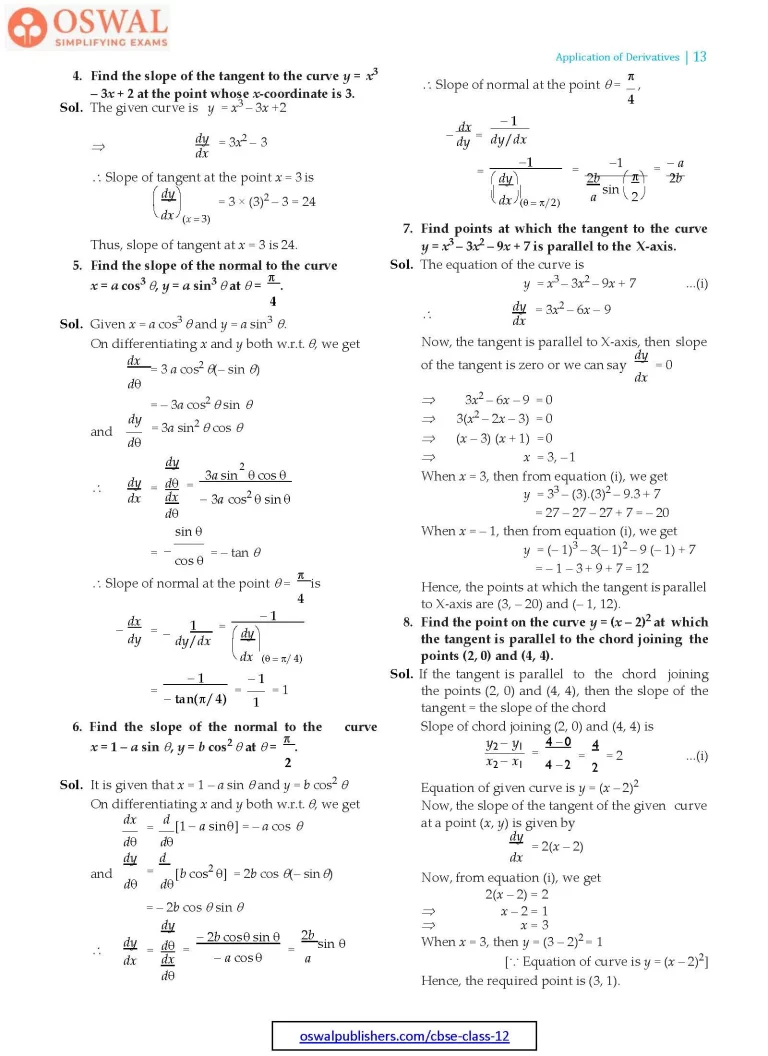
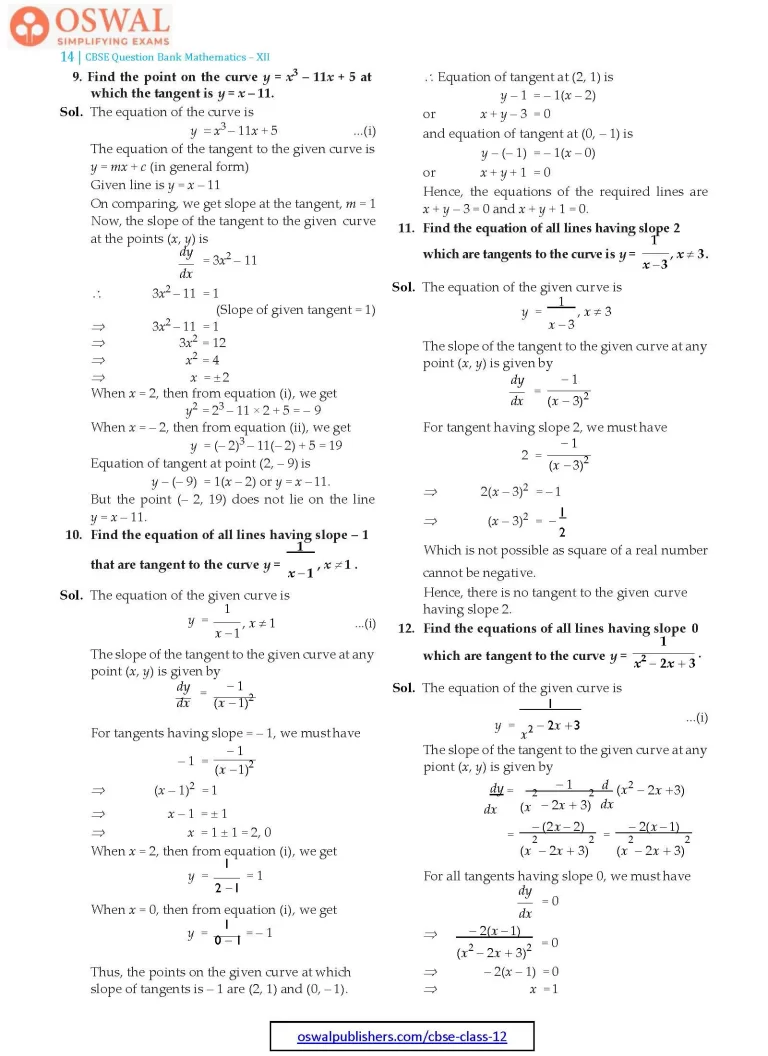
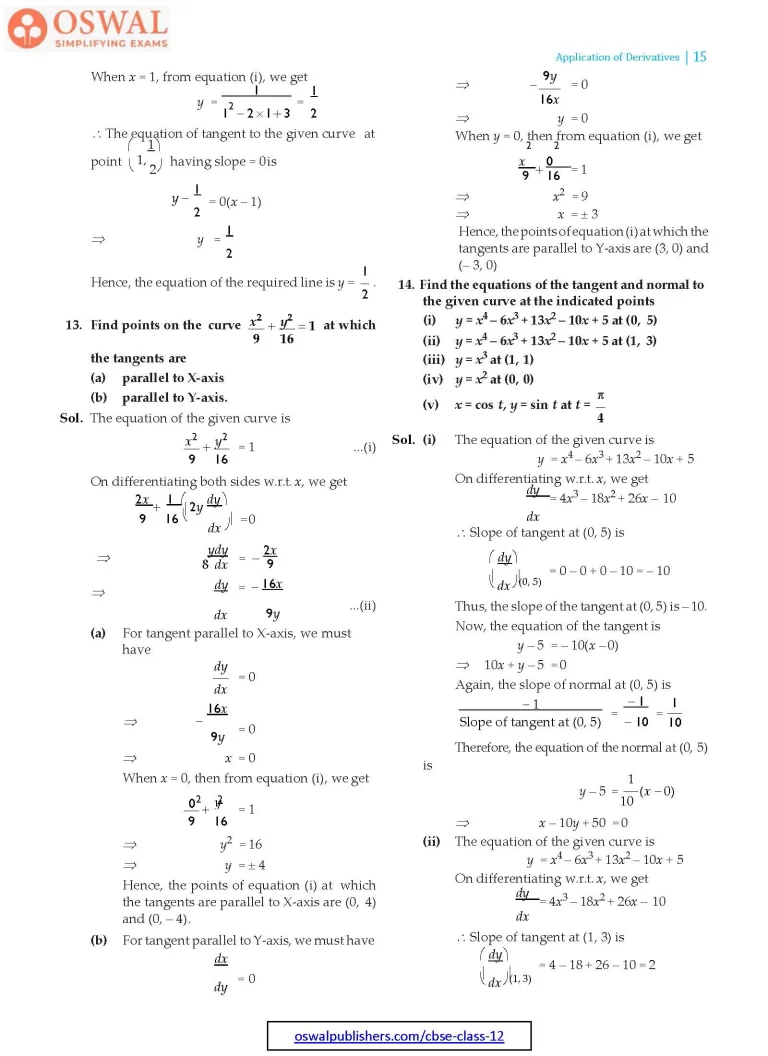
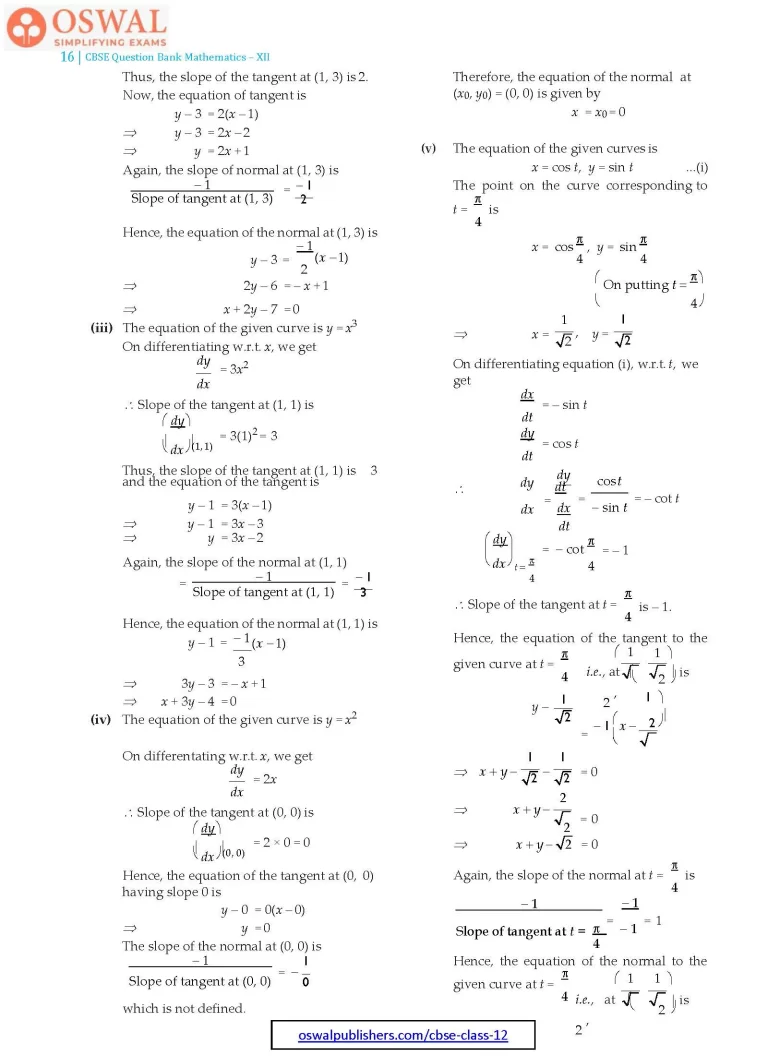
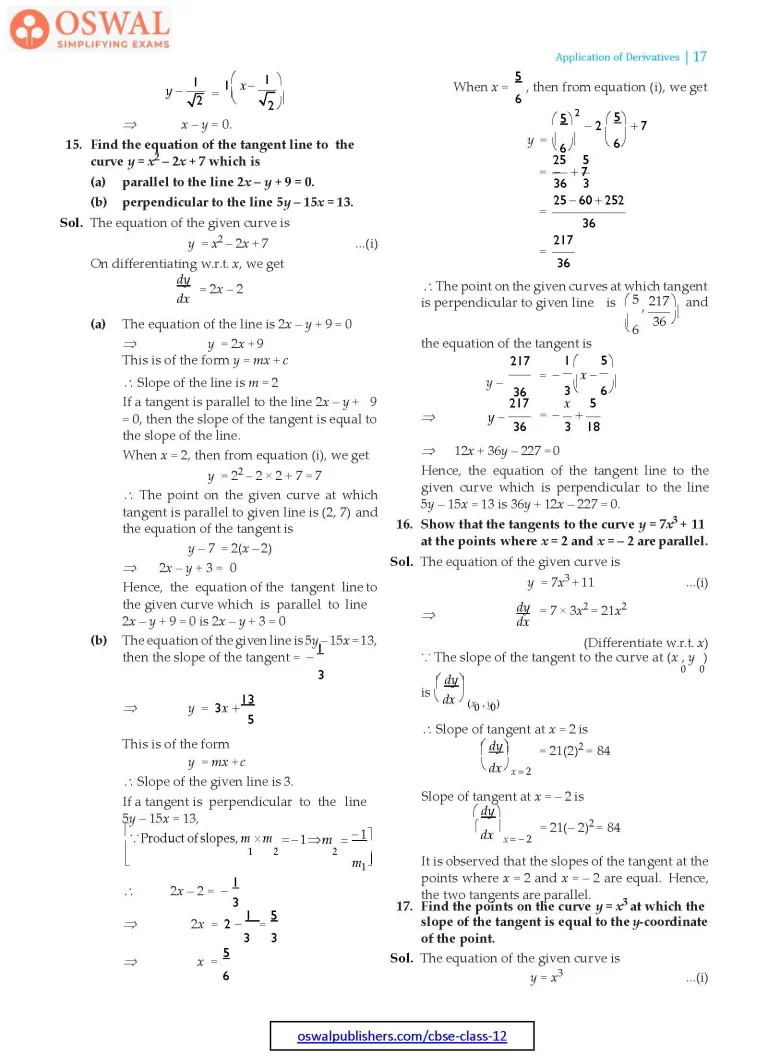
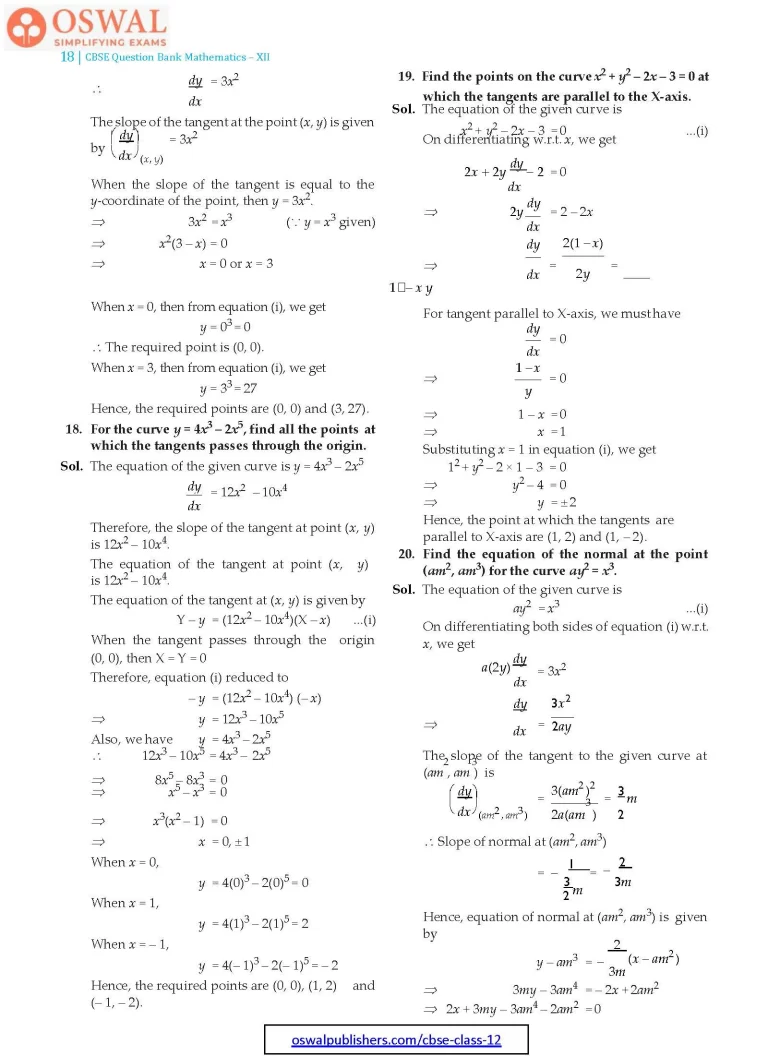
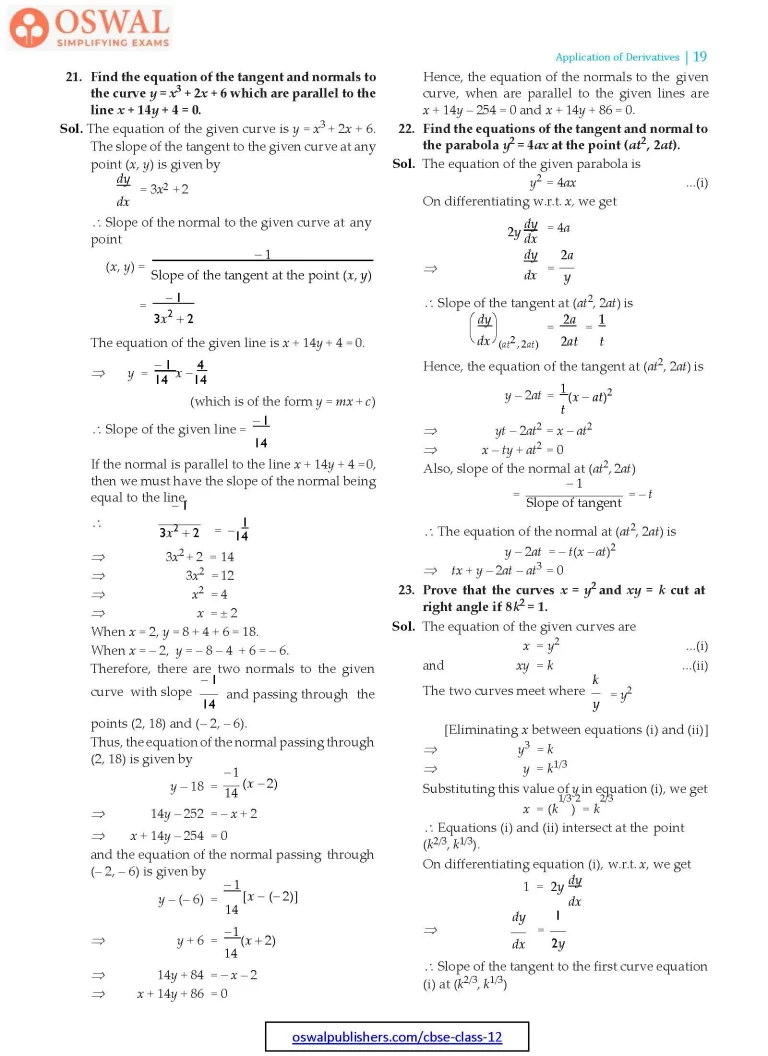
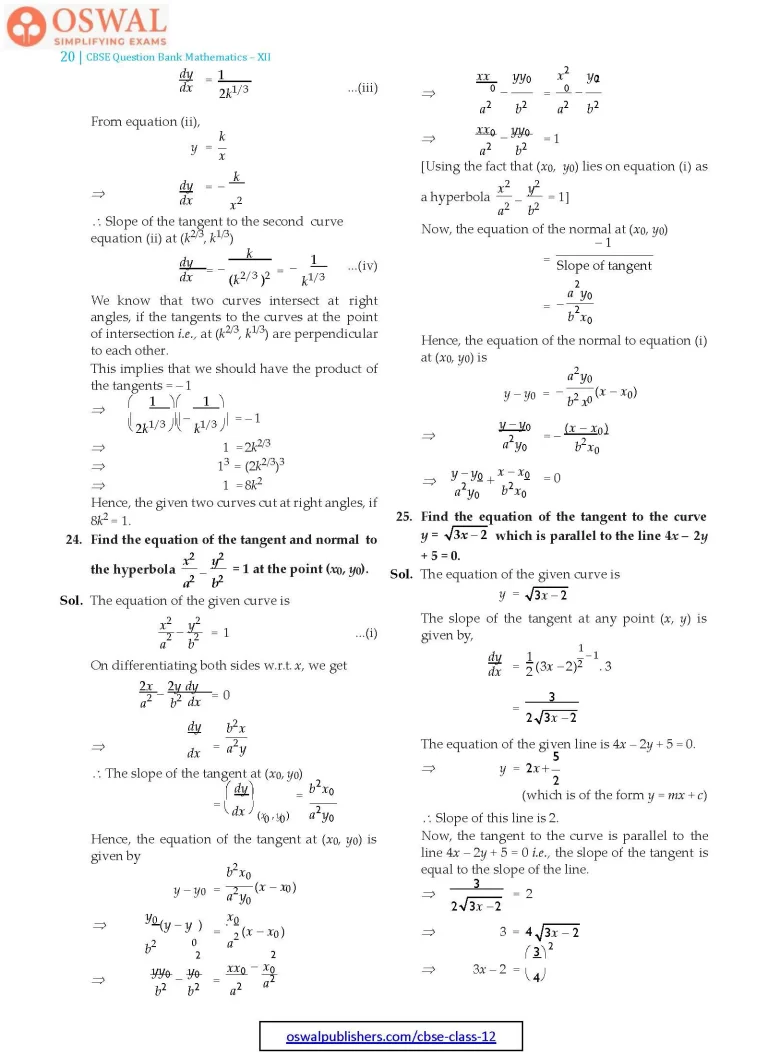
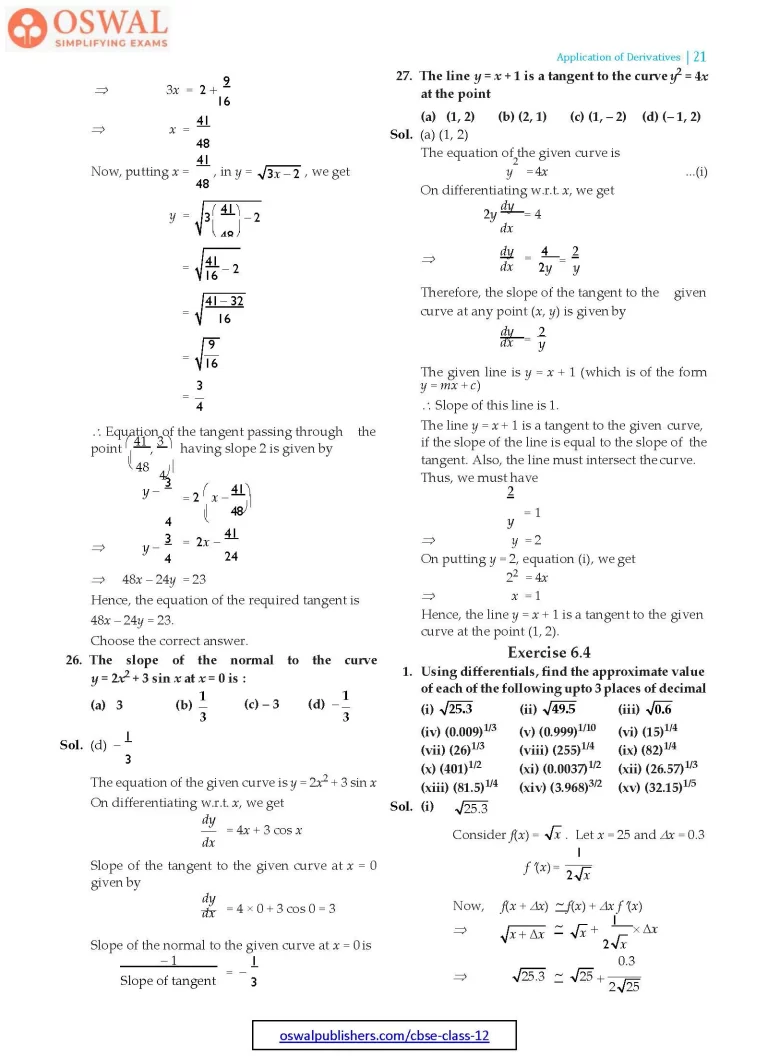
Access Exercises of Class 12 Maths Chapter 6 Application of Derivatives
Exercise 6.1 Solutions: 18 Questions (10 Long, 6 Short, 2 MCQs)
Exercise 6.2 Solutions: 19 Questions (10 Long, 7 Short, 2 MCQs)
Exercise 6.3 Solutions: 27 Questions (14 Long, 11 Short, 2 MCQs)
Exercise 6.4 Solutions: 9 Questions (7 Short, 2 MCQs)
Exercise 6.5 Solutions: 29 Questions (15 Long, 11 Short, 3 MCQs)
Miscellaneous Exercise Solutions: 24 Questions (14 Long, 4 Short, 6 MCQs)
Exercise 6.3
1. Find the slope of the tangent to the curve y = 3x4 – 4x at x = 4.
Sol. The given curve is y = 3x4 – 4x
Differentiating w.r.t. x, we get
$$\frac{dy}{dx}=\frac{d}{dx}[3x^4-4x]\\\Rarr\space\frac{dy}{dx}= 3×4x^3-4×1=12x^3-4$$
∴ Slope of tangent at x = 4 is
$$\bigg(\frac{dy}{dx}\bigg)_{x=4}=12×(4)^3-4=764$$
2. Find the slope of the tangent to the curve
$$\textbf{y}=\frac{\textbf{x-1}}{\textbf{x-2}},\space\textbf{x}\neq\textbf{2 at x=10.}\\\textbf{Sol.}\space\text{Given curve is, y =}\frac{\text{x-1}}{\text{x-2}}$$
On differentiating, we get
$$\frac{dy}{dx}=\frac{(x-2)\frac{d}{dx}(x-1)-(x-1)\frac{d}{dx}(x-2)}{(x-2)^2}\\\text{(Using quotient rule)}\\\Rarr\space\frac{dy}{dx}=\frac{(x-2)×1-(x-1)×1}{(x-2)^2}\\=\frac{x-2-x+1}{(x-2)^2}=\frac{-1}{(x-2)^2}\\\therefore\space \text{Slope of tangent at x = 10 is}\space\bigg(\frac{dy}{dx}\bigg)_{(x=10)}\\=\frac{-1}{(10-2)^2}=-\frac{1}{8^2}=-\frac{1}{64}\\\text{Hence, the slope of the tangent at x = 10 is}\\\frac{1}{64}.$$
3. Find the slope of the tangent to curve y = x3 – x + 1 at the point whose x-coordinate is 2.
Sol. The given curve is y = x3 – x + 1
$$\Rarr\space\frac{dy}{dx}=3x^2-1$$
∴ Slope of tangent at the given point x = 2 is
$$\bigg(\frac{dy}{dx}\bigg)_{(x=2)}\space = 3(2)^2-1=11$$
Thus, slope of tangent at x = 2 is 11.
4. Find the slope of the tangent to the curve y = x3 – 3x + 2 at the point whose x-coordinate is 3.
Sol. The given curve is y = x3 – 3x + 2
$$\Rarr\space\frac{dy}{dx}=3x^2-3$$
∴ Slope of tangent at the point x = 3 is
$$\bigg(\frac{dy}{dx}\bigg)_{(x=3)}\space=\text{3 × (3)}^{2} \text{– 3 = 24}$$
Thus, slope of tangent at x = 3 is 24.
5. Find the slope of the normal to the curve
$$\textbf{x = a cos}^3 \theta, \textbf{y = a sin}^3 \theta \space\text{at}\space \theta =\frac{\pi}{\textbf{4}}\textbf{.}$$
Sol. Given x = a cos3 θ and y = a sin3 θ.
On differentiating x and y both w.r.t. θ, we get
$$\frac{dx}{d\theta}=3 \space a\text{cos}^2\theta(-\text{sin}\theta)\\=-3a\space\text{cos}^2\theta\space \text{sin}\theta\\\text{and}\space\frac{dy}{d\theta}= 3 a\text{sin}^2\theta\text{cos}\theta\\\therefore\space\frac{dy}{dx}=\frac{\frac{dy}{d\theta}}{\frac{dx}{d\theta}}=\frac{3a \space\text{sin}^2\theta\text{cos}\theta}{-3a\space\text{cos}^2\theta\space \text{sin}\theta}\\=-\frac{\text{sin}\theta}{\text{cos}\theta}=-\text{tan}\theta\\\therefore\space \text{Slope of normal at the point} \theta =\frac{\pi}{4}\space\text{is}\\-\frac{dx}{dy}=-\frac{1}{dy/dx}\\=\frac{-1}{\bigg(\frac{dy}{dx}\bigg)}_{(\theta =\pi/4)}$$
$$=\frac{-1}{-\text{tan}(\pi/4)}=\frac{-1}{1}=1$$
6. Find the slope of the normal to the curve
$$\textbf{x = 1 – a sin}\space\theta ,\textbf{ y = b cos}^2 \theta \space\textbf{at}\space \theta =\frac{\pi}{\textbf{2}}.$$
Sol. It is given that x = 1 – a sin θ and y = b cos2 θ
On differentiating x and y both w.r.t. θ, we get
$$\frac{dx}{d\theta}=\frac{d}{d\theta}[1-a \space\text{sin}\theta]=-a\space\text{cos}\space\theta\\\text{and}\space\frac{dy}{d\theta}=\frac{d}{d\theta}[b \space\text{cos}^2\theta]=2b\space\text{cos}\theta(-\text{sin}\theta)\\=-2b \space\text{cos}\theta\space\text{sin}\theta\\\therefore\space\frac{dy}{dx}=\frac{\frac{dy}{d\theta}}{\frac{dx}{d\theta}}=\frac{-2b\space\text{cos}\theta\text{sin}\theta}{-a \text{cos}\theta}\\=\frac{2b}{a}\space\text{sin}\theta\\\therefore\space\text{Slope of normal at the point}\space\theta =\frac{\pi}{4},\\-\frac{dx}{dy}=\frac{1}{dy/dx}\\=\frac{-1}{\bigg(\frac{dy}{dx}\bigg)_{(\theta=\frac{\pi}{2})}}=\frac{-1}{\frac{2b}{a}\space\text{sin}\bigg(\frac{\pi}{2}\bigg)}=\frac{-a}{2b}$$
7. Find points at which the tangent to the curve y = x3 – 3x2 – 9x + 7 is parallel to the X-axis.
Sol. The equation of the curve is
y = x3 – 3x2 – 9x + 7 ...(i)
$$\therefore\space\frac{dy}{dx}=3x^2-6x-9$$
Now , the tangent is parallel to X-axis, then slope of the tangent is zero or we can say
$$\frac{dy}{dx}=0$$
⇒ 3x2 – 6x – 9 = 0
⇒ 3(x2 – 2x – 3) = 0
⇒ (x – 3) (x + 1) = 0
⇒ x = 3, – 1
When x = 3, then from equation (i), we get
y = 33 – (3).(3)2 – 9.3 + 7
= 27 – 27 – 27 + 7 = – 20
When x = – 1, then from equation (i), we get
y = (– 1)3 – 3(– 1)2 – 9 (– 1) + 7
= – 1 – 3 + 9 + 7 = 12
Hence, the points at which the tangent is parallel to X-axis are (3, – 20) and (– 1, 12).
8. Find the point on the curve y = (x – 2)2 at which the tangent is parallel to the chord joining the points (2, 0) and (4, 4).
Sol. If the tangent is parallel to the chord joining the points (2, 0) and (4, 4), then the slope of the tangent = the slope of the chord
Slope of chord joining (2, 0) and (4, 4) is
$$\frac{y_2-y_1}{x_2-x_1}=\frac{4-0}{4-2}\\=\frac{4}{2}=2\space\text{...(i)}$$
Equation of given curve is y = (x – 2)2
Now , the slope of the tangent of the given curve at a point (x, y) is given by
$$\frac{dy}{dx}=2(x-2)$$
Now , from equation (i), we get
2(x – 2) = 2
⇒ x – 2 = 1
⇒ x = 3
When x = 3, then y = (3 – 2)2 = 1
[∵ Equation of curve is y = (x – 2)2]
Hence, the required point is (3, 1).
9. Find the point on the curve y = x3 – 11x + 5 at which the tangent is y = x – 11.
Sol. The equation of the curve is
y = x3 – 11x + 5 ...(i)
The equation of the tangent to the given curve is y = mx + c (in general form)
Given line is y = x – 11
On comparing, we get slope at the tangent, m = 1
Now , the slope of the tangent to the given curve at the points (x, y) is
$$\frac{dy}{dx}=3x^2-11$$
∴ 3x2 – 11 = 1
(Slope of given tangent = 1)
⇒ 3x2 – 11 = 1
⇒ 3x2 = 12
⇒ x2 = 4
⇒ x = ± 2
When x = 2, then from equation (i), we get
y2 = 23 – 11 × 2 + 5 = – 9
When x = – 2, then from equation (ii), we get
y = (– 2)3 – 11(– 2) + 5 = 19
Equation of tangent at point (2, – 9) is
y – (– 9) = 1(x – 2) or y = x – 11.
But the point (– 2, 19) does not lie on the line y = x – 11.
10. Find the equation of all lines having slope – 1 that are tangent to the curve
$$\textbf{y}=\frac{\textbf{1}}{\textbf{x-1}},\space \textbf{x}\neq \textbf{1.}$$
Sol. The equation of the given curve is
$$y=\frac{1}{x-1},x\neq1\space\text{...(i)}$$
The slope of the tangent to the given curve at any point (x, y) is given by
$$\frac{dy}{dx}=\frac{-1}{(x-1)^2}$$
For tangents having slope = – 1, we must have
$$-1=\frac{-1}{(x-1)^2}$$
⇒ (x – 1)2 = 1
⇒ x – 1 = ± 1
⇒ x = 1 ± 1 = 2, 0
When x = 2, then from equation (i), we get
$$y=\frac{1}{2-1}=1$$
When x = 0, then from equation (i), we get
$$y=\frac{1}{0-1}=-1$$
Thus, the points on the given curve at which slope of tangents is – 1 are (2, 1) and (0, – 1).
∴ Equation of tangent at (2, 1) is
y – 1 = – 1(x – 2)
or
x + y – 3 = 0
and equation of tangent at (0, – 1) is
y – (– 1) = – 1(x – 0)
or
x + y + 1 = 0
Hence, the equations of the required lines are x + y – 3 = 0 and x + y + 1 = 0.
11. Find the equation of all lines having slope 2 which are tangents to the curve is
$$\textbf{y}=\frac{\textbf{1}}{\textbf{x-3}},\space \textbf{x}\neq \textbf{3.}$$
Sol. The equation of the given curve is
$$y=\frac{1}{x-3},\space x\neq 3$$
The slope of the tangent to the given curve at any point (x, y) is given by
$$\frac{dy}{dx}=\frac{-1}{(x-3)^2}$$
For tangent having slope 2, we must have
$$2=\frac{-1}{(x-3)^2}$$
⇒ 2(x – 3)2 = – 1
$$\Rarr\space (x-3)^2=-\frac{1}{2}$$
Which is not possible as square of a real number cannot be negative.
Hence, there is no tangent to the given curve having slope 2.
12. Find the equations of all lines having slope 0 which are tangent to the curve
$$\textbf{y = }\frac{\textbf{1}}{\textbf{x}^2\textbf{-2x+3}}\textbf{.}$$
Sol. The equation of the given curve is
$$y=\frac{1}{x^2-2x+3}\space\text{...(i)}$$
The slope of the tangent to the given curve at any piont (x, y) is given by
$$\frac{dy}{dx}=\frac{-1}{(x^2-2x+3)^2}\frac{d}{dx}(x^2-2x+3)\\=\frac{-(2x+2)}{(x^2-2x+3)^2}=\frac{1}{(x^2-2x+3)^2}$$
For all tangents having slope 0, we must have
$$\frac{dy}{dx}=0\\\Rarr\space\frac{-2(x-1)}{(x^2-2x+3)^2}=0$$
⇒ – 2(x – 1) = 0
⇒ x = 1
When x = 1, from equation (i), we get
$$y=\frac{1}{1^2-2×1+3}=\frac{1}{3}$$
∴ The equation of tangent to the given curve at point
$$\bigg(1,\frac{1}{2}\bigg)\space\text{having slope = 0 is}\\ y=\frac{1}{2}=0(x-1)\\\Rarr\space y=\frac{1}{2}\\\text{Hence, the equation of the required line is}\\ y=\frac{1}{2}.$$
13. Find points on the curve
$$\frac{\textbf{x}^\textbf{2}}{\textbf{9}}+\frac{\textbf{y}^\textbf{2}}{\textbf{16}}\textbf{= 1}\space\textbf{at which the tangents are}$$
(a) parallel to X-axis
(b) parallel to Y-axis.
Sol. The equation of the given curve is
$$\frac{x^2}{9}+\frac{y^2}{16}=1\space \text{...(i)}$$
On differentiating both sides w.r.t. x, we get
$$\frac{2x}{9}+\frac{1}{16}\bigg(2y\frac{dy}{dx}\bigg)=0\\\Rarr\space \frac{y}{8}\frac{dy}{dx}=-\frac{2x}{9}\\\Rarr\space\frac{dy}{dx}=-\frac{16 x}{9y}\space\text{...(ii)}$$
(a) For tangent parallel to X-axis, we must have
$$\frac{dy}{dx}=0\\\Rarr\space -\frac{16 x}{9y}=0$$
⇒ x = 0
When x = 0, then from equation (i), we get
$$\frac{0^2}{9}+\frac{y^2}{16}=1$$
⇒ y2 = 16
⇒ y = ± 4
Hence, the points of equation (i) at which the tangents are parallel to X-axis are (0, 4) and (0, – 4).
(b) For tangent parallel to Y-axis, we must have
$$\frac{dx}{dy}=0\\\Rarr\space -\frac{9y}{16x}=0$$
⇒ y = 0
When y = 0, then from equation (i), we get
$$\frac{x^2}{9}+\frac{y^2}{16}=1$$
⇒ x2 = 9
⇒ x = ± 3
Hence, the points of equation (i) at which the tangents are parallel to Y-axis are (3, 0) and (– 3, 0)
14. Find the equations of the tangent and normal to the given curve at the indicated points
(i) y = x4 – 6x3 + 13x2 – 10x + 5 at (0, 5)
(ii) y = x4 – 6x3 + 13x2 – 10x + 5 at (1, 3)
(iii) y = x3 at (1, 1)
(iv) y = x2 at (0, 0)
$$\textbf{(v) x = cos t, y = sin t at t}=\frac{\pi}{\textbf{4}}$$
Sol. (i) The equation of the given curve is
y = x4 – 6x3 + 13x2 – 10x + 5
On differentiating w.r.t. x, we get
$$\frac{dy}{dx}=4x^3-18x^2+26x-10$$
∴ Slope of tangent at (0, 5) is
$$\bigg(\frac{dy}{dx}\bigg)_{0,5}=0-0+0-10=-10$$
Thus, the slope of the tangent at (0, 5) is – 10.
Now, the equation of the tangent is
y – 5 = – 10(x – 0)
⇒ 10x + y – 5 = 0
Again, the slope of normal at (0, 5) is
$$\frac{-1}{\text{Slope of tangent at (0, 5)}}=\frac{-1}{-10}\\=\frac{1}{10}$$
Therefore, the equation of the normal at (0, 5) is
$$y-5=\frac{1}{10}(x-0)$$
⇒ x – 10y + 50 = 0
(ii) The equation of the given curve is
y = x4 – 6x3 + 13x2 – 10x + 5
On differentiating w.r.t. x, we get
$$\frac{dy}{dx}=4x^3-18x^2+26x-10$$
∴ Slope of tangent at (1, 3) is
$$\bigg(\frac{dy}{dx}\bigg)_{(1,3)}=4-18+26-10=2$$
Thus, the slope of the tangent at (1, 3) is 2.
Now, the equation of tangent is
y – 3 = 2(x – 1)
⇒ y – 3 = 2x – 2
⇒ y = 2x + 1
Again, the slope of normal at (1, 3) is
$$\frac{-1}{\text{Slope of tangent at (1, 3)}}=\frac{-1}{2}$$
Hence, the equation of the normal at (1, 3) is
$$y-3=\frac{-1}{2}(x-1)$$
⇒ 2y – 6 = – x + 1
⇒ x + 2y – 7 = 0
(iii) The equation of the given curve is y = x3
On differentiating w.r.t. x, we get
$$\frac{dy}{dx}=3x^2$$
∴ Slope of the tangent at (1, 1) is
$$\bigg(\frac{dy}{dx}\bigg)_{(1,1)}=3(1)^2=3$$
Thus, the slope of the tangent at (1, 1) is 3 and the equation of the tangent is
y – 1 = 3(x – 1)
⇒ y – 1 = 3x – 3
⇒ y = 3x – 2
Again, the slope of the normal at (1, 1)
$$=\frac{1}{\text{Slope of tangent at (1, 1)}}=\frac{-1}{3}$$
Hence, the equation of the normal at (1, 1) is
$$y-1=\frac{-1}{3}(x-1)$$
⇒ 3y – 3 = – x + 1
⇒ x + 3y – 4 = 0
(iv) The equation of the given curve is y = x2
On differentating w.r.t. x, we get
$$\frac{dy}{dx}=2x\\\therefore\space\text{Slope of the tangent at (0, 0) is}\\\bigg(\frac{dy}{dx}\bigg)_{(0,0)}=2×0=0$$
Hence, the equation of the tangent at (0, 0) having slope 0 is
y – 0 = 0(x – 0)
⇒ y = 0
The slope of the normal at (0, 0) is
$$\frac{-1}{\text{Slope of tangent at (0,0)}}=-\frac{1}{0}$$
which is not defined.
Therefore, the equation of the normal at
(x0, y0) = (0, 0) is given by
x = x0 = 0
(v) The equation of the given curves is
x = cos t, y = sin t ...(i)
The point on the curve corresponding to
$$t=\frac{\pi}{4}\space\text{is}\\\text{ x = cos}\frac{\pi}{4},\text{ y = sin}\frac{\pi}{4}\\\bigg(\text{On putting t=}\frac{\pi}{4}\bigg)\\\Rarr\space x=\frac{1}{\sqrt{2}}, y=\frac{1}{\sqrt{2}}$$
On differentiating equation (i), w.r.t. t, we get
$$\frac{dx}{dt}=-\text{sin t}\\\frac{dy}{dt}=\text{cos t}\\\therefore\space \frac{dy}{dx}=\frac{\frac{dy}{dt}}{\frac{dx}{dt}}=\frac{\text{cos t}}{\text{- sin t}}=-\text{cot t}\\\bigg(\frac{dy}{dx}\bigg)_{t=\frac{\pi}{4}}=-\text{cot}\frac{\pi}{4}=-1\\\therefore\space\text{Slope of the tangent at t =}\frac{\pi}{4}\space\text{is} -1.$$
Hence, the equation of the tangent to the given curve at
$$t=\frac{\pi}{4}\space\text{i.e, at}\space\bigg(\frac{1}{\sqrt{2}},\frac{1}{\sqrt{2}}\bigg)\space\text{is}\\ y-\frac{1}{\sqrt{2}}=-1\bigg(x-\frac{1}{\sqrt{2}}\bigg)\\\Rarr\space x+y-\frac{1}{\sqrt{2}}-\frac{1}{\sqrt{2}}=0\\\Rarr\space x+y-\frac{2}{\sqrt{2}}=0\\\Rarr\space x+y-\sqrt{2}=0$$
$$\text{Again, the slope of the normal at t}\\=\frac{\pi}{4}\space\text{is}\space\frac{1}{\text{Slope of tangent at t}=\frac{\pi}{4}}\\=\frac{-1}{-1}=1$$
Hence, the equation of the normal to the given curve at
$$t=\frac{\pi}{4}\space\text{i.e. at}\space \bigg(\frac{1}{\sqrt{2}},\frac{1}{\sqrt{2}}\bigg)\space\text{is}\\ y-\frac{1}{\sqrt{2}}=1\bigg(x-\frac{1}{\sqrt{2}}\bigg)$$
⇒ x – y = 0.
15. Find the equation of the tangent line to the curve y = x2 – 2x + 7 which is
(a) parallel to the line 2x – y + 9 = 0.
(b) perpendicular to the line 5y – 15x = 13.
Sol. The equation of the given curve is
y = x2 – 2x + 7 ...(i)
On differentiating w.r.t. x, we get
$$\frac{dy}{dx}=2x-2$$
(a) The equation of the line is 2x – y + 9 = 0
⇒ y = 2x + 9
This is of the form y = mx + c
∴ Slope of the line is m = 2
If a tangent is parallel to the line 2x – y + 9 = 0, then the slope of the tangent is equal to the slope of the line.
When x = 2, then from equation (i), we get
y = 22 – 2 × 2 + 7 = 7
∴ The point on the given curve at which tangent is parallel to given line is (2, 7) and the equation of the tangent is
y – 7 = 2(x – 2)
⇒ 2x – y + 3 = 0
Hence, the equation of the tangent line to the given curve which is parallel to line 2x – y + 9 = 0 is 2x – y + 3 = 0
(b) The equation of the given line is 5y – 15x = 13,
$$\text{then the slope of the tangent = −}\frac{1}{3}\\\Rarr\space y= 3x+\frac{13}{5}$$
This is of the form
y = mx + c
∴ Slope of the given line is 3.
If a tangent is perpendicular to the line
5y – 15x = 13,
$$\bigg[\because\space\text{Product of slopes,}m_1×m_2=-1\Rarr m_2=\frac{-1}{m_1}\bigg]$$
$$\therefore\space\text{2x-2}=-\frac{1}{3}\\\Rarr\space 2x=2-\frac{1}{3}=\frac{5}{3}\\\Rarr\space x=\frac{5}{6}\\\text{When x=}\frac{5}{6},\space\text{then from equation (i), we get}\\ y=\bigg(\frac{5}{6}\bigg)^2-2\bigg(\frac{5}{6}\bigg)+7\\=\frac{25}{3}-\frac{5}{3}+7\\=\frac{25-60+252}{36}\\=\frac{217}{36}$$
∴ The point on the given curves at which tangent is perpendicular to given line is
$$\bigg(\frac{5}{6},\frac{217}{36}\bigg)\space\text{and the equation of the tangent is}$$
$$y-\frac{217}{36}\\=-\frac{1}{3}\bigg(x-\frac{5}{6}\bigg)\\\Rarr\space y-\frac{217}{36}\\=-\frac{x}{3}+\frac{5}{18}$$
⇒ 12x + 36y – 227 = 0
Hence, the equation of the tangent line to the given curve which is perpendicular to the line
5y – 15x = 13 is 36y + 12x – 227 = 0.
16. Show that the tangents to the curve y = 7x3 + 11 at the points where x = 2 and x = – 2 are parallel.
Sol. The equation of the given curve is
y = 7x3 + 11 ...(i)
$$\Rarr\space\frac{dy}{dx}=7×3x^2=21x^2$$
(Differentiate w.r.t. x)
∵ The slope of the tangent to the curve at (x0, y0) is $$\bigg(\frac{dy}{dx}\bigg)_{(x_0,y_0)}$$
∴ Slope of tangent at x = 2 is
$$\bigg(\frac{dy}{dx}\bigg)_{x=2} = 21(2)^2=84$$
Slope of tangent at x = – 2 is
$$\bigg(\frac{dy}{dx}\bigg)_{x=-2}=21(-2)^2=84$$
It is observed that the slopes of the tangent at the points where x = 2 and x = – 2 are equal. Hence, the two tangents are parallel.
17. Find the points on the curve y = x3 at which the slope of the tangent is equal to the y-coordinate of the point.
Sol. The equation of the given curve is
y = x3 ...(i)
$$\therefore\space\frac{dy}{dx}=3x^2$$
The slope of the tangent at the point (x, y) is given by
$$\bigg(\frac{dy}{dx}\bigg)_{(x,y)}=3x^2$$
When the slope of the tangent is equal to the y-coordinate of the point, then y = 3x2.
⇒ 3x2 = x3 (∵ y = x3 given)
⇒ x2(3 – x) = 0
⇒ x = 0 or x = 3
When x = 0, then from equation (i), we get
y = 03 = 0
∴ The required point is (0, 0).
When x = 3, then from equation (i), we get
y = 33 = 27
Hence, the required points are (0, 0) and (3, 27).
18. For the curve y = 4x3 – 2x5, find all the points at which the tangents passes through the origin.
Sol. The equation of the given curve is y = 4x3 – 2x5
$$\frac{dy}{dx}=12x^2-10x^4$$
Therefore, the slope of the tangent at point (x, y) is 12x2 – 10x4.
The equation of the tangent at point (x, y)
is 12x2 – 10x4.
The equation of the tangent at (x, y) is given by
Y – y = (12x2 – 10x4)(X – x) ...(i)
When the tangent passes through the origin
(0, 0), then X = Y = 0
Therefore, equation (i) reduced to
– y = (12x2 – 10x4) (– x)
⇒ y = 12x3 – 10x5
Also, we have y = 4x3 – 2x5
∴ 12x3 – 10x5 = 4x3 – 2x5
⇒ 8x5 – 8x3 = 0
⇒ x5 – x3 = 0
⇒ x3(x2 – 1) = 0
⇒ x = 0, ± 1
When x = 0,
y = 4(0)3 – 2(0)5 = 0
When x = 1,
y = 4(1)3 – 2(1)5 = 2
When x = – 1,
y = 4(– 1)3 – 2(– 1)5 = – 2
Hence, the required points are (0, 0), (1, 2) and (– 1, – 2).
19. Find the points on the curve x2 + y2 – 2x – 3 = 0 at which the tangents are parallel to the X-axis.
Sol. The equation of the given curve is
x2 + y2 – 2x – 3 = 0 ...(i)
On differentiating w.r.t. x, we get
$$2x+2y\frac{dy}{dx}-2=0\\\Rarr\space 2y\frac{dy}{dx}=2-2x\\\Rarr\space \frac{dy}{dx}=\frac{2(1-x)}{2y}=\frac{1-x}{y}$$
For tangent parallel to X-axis, we must have
$$\frac{dy}{dx}=0\\\Rarr\space \frac{1-x}{y}=0$$
⇒ 1 – x = 0
⇒ x = 1
Substituting x = 1 in equation (i), we get
12 + y2 – 2 × 1 – 3 = 0
⇒ y2 – 4 = 0
⇒ y = ± 2
Hence, the point at which the tangents are parallel to X-axis are (1, 2) and (1, – 2).
20. Find the equation of the normal at the point (am2, am3) for the curve ay2 = x3.
Sol. The equation of the given curve is
ay2 = x3 ...(i)
On differentiating both sides of equation (i) w.r.t. x, we get
$$\text{a(2y)}\frac{dy}{dx}=3x^2\\\Rarr\space\frac{dy}{dx}=\frac{3x^2}{2ay}$$
The slope of the tangent to the given curve at (am2, am3) is
$$\bigg(\frac{dy}{dx}\bigg)_{(am^2,am^3)}=\frac{3(am^2)^2}{2a(am)^3}=\frac{3}{2}m$$
∴ Slope of normal at (am2, am3)
$$=\space\frac{1}{\frac{3}{2}m}=-\frac{2}{3m}$$
Hence, equation of normal at (am2, am3) is given by
$$\text{y - am}^{3}=-\frac{2}{3m}(x-am^2)$$
⇒ 3my – 3am4 = – 2x + 2am2
⇒ 2x + 3my – 3am4 – 2am2 = 0
21. Find the equation of the tangent and normals to the curve y = x3 + 2x + 6 which are parallel to the line x + 14y + 4 = 0.
Sol. The equation of the given curve is y = x3 + 2x + 6.
The slope of the tangent to the given curve at any point (x, y) is given by
$$\frac{dy}{dx}=3x^2+2$$
∴ Slope of the normal to the given curve at any point
$$(x,y)=\frac{-1}{\text{Slope of the tangent at the point (x,y)}}\\=\frac{-1}{3x^2+2}$$
The equation of the given line is x + 14y + 4 = 0.
$$\Rarr\space y=\frac{-1}{14}x-\frac{4}{14}$$
(which is of the form y = mx + c)
$$\therefore\space\text{Slope of the given line =}\frac{-1}{14}$$
If the normal is parallel to the line x + 14y + 4 = 0, then we must have the slope of the normal being equal to the line.
$$\therefore\space\frac{-1}{3x^2+2}=-\frac{1}{14}$$
⇒ 3x2 + 2 = 14
⇒ 3x2 = 12
⇒ x2 = 4
⇒ x = ± 2
When x = 2, y = 8 + 4 + 6 = 18.
When x = – 2, y = – 8 – 4 + 6 = – 6.
Therefore, there are two normals to the given curve with slope
$$\frac{-1}{14}\space\text{and passing through the points}\\\text{ (2, 18) and (– 2, – 6).}$$
Thus, the equation of the normal passing through (2, 18) is given by
$$\text{y-18}=\frac{-1}{14}(x-2)$$
⇒ 14y – 252 = – x + 2
⇒ x + 14y – 254 = 0
and the equation of the normal passing through (– 2, – 6) is given by
$$y-(-6)=\frac{-1}{14}[x-(-2)]\\\Rarr\space y+6=\frac{-1}{14}(x+2)$$
⇒ 14y + 84 = – x – 2
⇒ x + 14y + 86 = 0
Hence, the equation of the normals to the given curve, when are parallel to the given lines are x + 14y – 254 = 0 and x + 14y + 86 = 0.
22. Find the equations of the tangent and normal to the parabola y2 = 4ax at the point (at2, 2at).
Sol. The equation of the given parabola is
y2 = 4ax ...(i)
On differentiating w.r.t. x, we get
$$2y\frac{dy}{dx}=4a\\\Rarr\space \frac{dy}{dx}=\frac{2a}{y}$$
∴ Slope of the tangent at (at2, 2at) is
$$\bigg(\frac{dy}{dx}\bigg)_{(at^2,2at)}=\frac{2a}{2at}=\frac{1}{t}$$
Hence, the equation of the tangent at (at2, 2at) is
$$\text{y-2at}=\frac{1}{t}(x-at)^2$$
⇒ yt – 2at2 = x – at2
⇒ x – ty + at2 = 0
Also, slope of the normal at (at2, 2at)
$$=\frac{1}{\text{Slope of tangent}}=-t$$
∴ The equation of the normal at (at2, 2at) is
y – 2at = – t(x – at)2
⇒ tx + y – 2at – at3 = 0
23. Prove that the curves x = y2 and xy = k cut at right angle if 8k2 = 1s.
Sol. The equation of the given curves are
x = y2 ...(i)
and xy = k ...(ii)
$$\text{The two curves meet where}\space\frac{k}{y}=y^2$$
[Eliminating x between equations (i) and (ii)]
⇒ y3 = k
⇒ y = k1/3
Substituting this value of y in equation (i), we get
x = (k1/3)2 = k2/3
∴ Equations (i) and (ii) intersect at the point (k2/3, k1/3).
On differentiating equation (i), w.r.t. x, we get
$$1=2y\frac{dy}{dx}\\\Rarr\space \frac{dy}{dx}=\frac{1}{2y}$$
∴ Slope of the tangent to the first curve equation
(i) at (k2/3, k1/3)
$$\frac{dy}{dx}=\frac{1}{2k^{1/3}}\space\text{...(iii)}\\\text{From equation (ii),}\\y=\frac{k}{x}\\\Rarr\space \frac{dy}{dx}=-\frac{k}{x^2}$$
∴ Slope of the tangent to the second curve equation (ii) at (k2/3, k1/3)
$$\frac{dy}{dx}=-\frac{k}{(k^{2/3})^2}=-\frac{1}{k^{1/3}}\space\text{...(iv)}$$
We know that two curves intersect at right angles, if the tangents to the curves at the point of intersection i.e., at (k2/3, k1/3) are perpendicular to each other .
This implies that we should have the product of the tangents = – 1
$$\Rarr\space\bigg(\frac{1}{2k^{1/3}}\bigg)\bigg(-\frac{1}{k^{1/3}}\bigg)=-1$$
⇒ 1 = 2k2/3
⇒ 13 = (2k2/3)3
⇒ 1 = 8k2
Hence, the given two curves cut at right angles, if 8k2 = 1.
24. Find the equation of the tangent and normal to the hyperbola $$\frac{\textbf{x}^\textbf{2}}{\textbf{a}^\textbf{2}}\textbf{-}\frac{\textbf{y}^\textbf{2}}{\textbf{b}^\textbf{2}}\textbf{=1}$$
at the point (x0, y0).
Sol. The equation of the given curve is
$$\frac{\text{x}^\text{2}}{\text{a}^\text{2}}\text{-}\frac{\text{y}^\text{2}}{\text{b}^\text{2}}\text{= 1}\space \text{...(i)}$$
On differentiating both sides w.r.t. x, we get
$$\frac{2x}{a^2}-\frac{2y}{b^2}\frac{dy}{dx}=0\\\Rarr\space\frac{dy}{dx}=\frac{b^2x}{a^2y}$$
∴ The slope of the tangent at (x0, y0)
$$=\bigg(\frac{dy}{dx}\bigg)_{(x_0,y_0)}=\frac{b^2x_0}{a^2y_0}$$
Hence, the equation of the tangent at (x0, y0) is given by
$$\text{y-y}_0=\frac{b^2x_0}{a^2y_0}(x-x_0)\\\Rarr\space \frac{y_0}{b^2}(y-y_0)=\frac{x_0}{a^2}(x-x_0)\\\Rarr\space \frac{yy_0}{b^2}-\frac{y^2_0}{b^2}\\=\frac{xx_0}{a^2}-\frac{x^2_0}{a^2}\\\Rarr\space \frac{xx_0}{a^2}-\frac{yy_0}{b^2}=\frac{x^2_0}{a^2}-\frac{y^2_0}{b^2}\\\Rarr\space\frac{xx_0}{a^2}-\frac{yy_0}{b^2}=1$$
[Using the fact that (x0, y0) lies on equation (i) as a hyperbola
$$\frac{x^2}{a^2}-\frac{y^2}{b^2}=1 \rbrack$$
Now , the equation of the normal at (x0, y0)
$$=\frac{-1}{\text{Slope of tangent}}\\=\frac{a^2y_0}{b^2x_0}$$
Hence, the equation of the normal to equation (i) at (x0, y0) is
$$\text{y-y}_0=-\frac{a^2y_0}{b^2x_0}(x-x_0)\\\Rarr\space\frac{y-y_0}{a^2y_0}=\frac{(x-x_0)}{b^2x_0}\\\Rarr\space \frac{y-y_0}{a^2y_0}+\frac{x-x_0}{b^2x_0}=0$$
25. Find the equation of the tangent to the curve
$$\textbf{y}=\sqrt{\textbf{3x-2}}\space\textbf{which is parallel to the}\\\textbf{line 4x – 2y + 5 = 0.}$$
Sol. The equation of the given curve is
$$y=\sqrt{3x-2}$$
The slope of the tangent at any point (x, y) is given by
$$\frac{dy}{dx}=\frac{1}{2}(3x-2)^{\frac{1}{2}-1}.3\\=\frac{3}{2\sqrt{3x-2}}$$
The equation of the given line is 4x – 2y + 5 = 0.
$$\Rarr\space y=2x+\frac{5}{2}$$
(which is of the form y = mx + c)
∴ Slope of this line is 2.
Now , the tangent to the curve is parallel to the line 4x – 2y + 5 = 0 i.e., the slope of the tangent is equal to the slope of the line.
$$\Rarr\space\frac{3}{2\sqrt{3x-2}}=2\\\Rarr\space 3 = 4\sqrt{3x-2}\\\Rarr\space 3x-2= \bigg(\frac{3}{4}\bigg)^2\\\Rarr\space 3x=2+\frac{9}{16}\\\Rarr\space x=\frac{41}{48}\\\text{Now, putting x =}\frac{41}{48},\space\\ \text{in y}=\sqrt{3x-2},\space\text{we get}\\y=\sqrt{3\bigg(\frac{41}{48}-2\bigg)}$$
$$=\sqrt{\frac{41}{16}-2}\\=\sqrt{\frac{41-32}{16}}\\=\sqrt{\frac{9}{16}}\\=\frac{3}{4}$$
∴ Equation of the tangent passing through the point
$$\bigg(\frac{41}{48},\frac{3}{4}\bigg)\space\text{having slope 2 is given by}\\y-\frac{3}{4}=2\bigg(x-\frac{41}{48}\bigg)\\\Rarr\space y-\frac{3}{4}=2x-\frac{41}{24}$$
⇒ 48x – 24y = 23
Hence, the equation of the required tangent is
48x – 24y = 23.
Choose the correct answer.
26. The slope of the normal to the curve
y = 2x2 + 3 sin x at x = 0 is :
(a) 3
$$\text{(b)}\space\frac{1}{3}$$
(c) – 3
$$\textbf{(d)}\space-\frac{\textbf{1}}{\textbf{3}}$$
$$\textbf{Sol.}\space\text{(d)}\space-\frac{1}{3}$$
The equation of the given curve is y = 2x2 + 3 sin x
On differentiating w.r.t. x, we get
$$\frac{dy}{dx}=4x+3\space\text{cos x}$$
Slope of the tangent to the given curve at x = 0 given by
$$\frac{dy}{dx}=4×0+3\space\text{cos}\space 0=3$$
Slope of the normal to the given curve at x = 0 is
$$\frac{-1}{\text{Slope of tangent}}=-\frac{1}{3}$$
27. The line y = x + 1 is a tangent to the curve y2 = 4x at the point
(a) (1, 2) (b) (2, 1) (c) (1, – 2) (d) (– 1, 2)
Sol. (a) (1, 2)
The equation of the given curve is
y2 = 4x ...(i)
On differentiating w.r.t. x, we get
$$2y\frac{dy}{dx}=4\\\Rarr\space \frac{dy}{dx}=\frac{4}{2y}=\frac{2}{y}$$
Therefore, the slope of the tangent to the given curve at any point (x, y) is given by
$$\frac{dy}{dx}=\frac{2}{y}$$
The given line is y = x + 1 (which is of the form y = mx + c)
∴ Slope of this line is 1.
The line y = x + 1 is a tangent to the given curve, if the slope of the line is equal to the slope of the tangent. Also, the line must intersect the curve.
Thus, we must have
$$\frac{2}{y}=1\\\Rarr\space\text{y = 2}$$
On putting y = 2, equation (i), we get
22 = 4x
⇒ x = 1
Hence, the line y = x + 1 is a tangent to the given curve at the point (1, 2).
